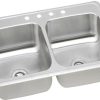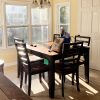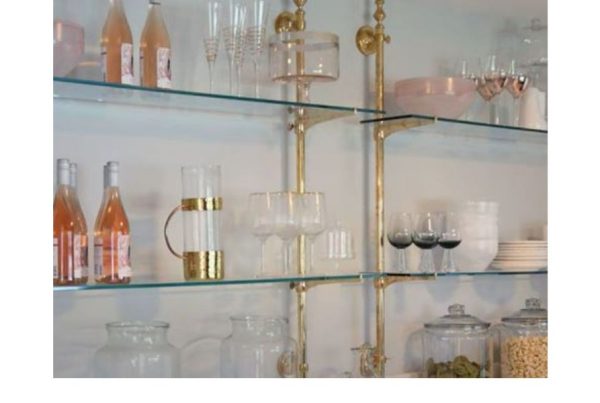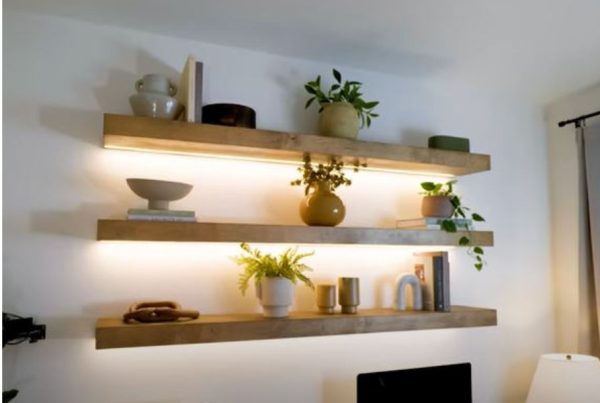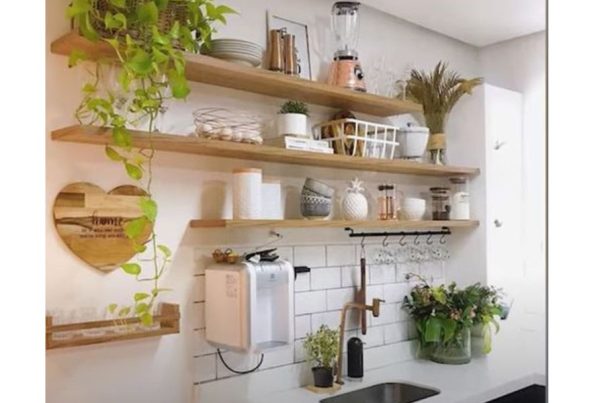When adding storage and style to your kitchen, floating shelves are a popular choice. They provide a sleek and modern look while offering a practical solution for organizing and displaying kitchen items. However, one question that often arises is, “How thick should kitchen floating shelves be?” In this article, we will explore the factors that influence the thickness of kitchen floating shelves and guide you in making the right decision for your space.
 Understanding Floating Shelves
Understanding Floating Shelves
Before we delve into the ideal thickness for kitchen floating shelves, let’s understand what floating shelves are. Floating shelves are minimalist and versatile shelving units that appear floating on the wall, hence the name. These shelves are supported by concealed brackets or remote support systems, giving them a sleek and seamless look. They provide a great way to display or store items while maximizing space and adding a touch of sophistication to your kitchen.
Benefits of Kitchen Floating Shelves
How thick should kitchen floating shelves offer numerous advantages over traditional shelving options? Here are a few key benefits:
- Open and Spacious Feel: how thick should kitchen floating shelves be? Create a relaxed and spacious atmosphere in your kitchen by eliminating the visual bulk of traditional cabinets.
- Versatile Storage: These shelves allow you to showcase your favorite cookbooks, display stylish dinnerware, or organize essential kitchen supplies.
- Easy Accessibility: how thick should kitchen floating shelves be, everything you need is within arm’s reach, making it convenient to grab and use your kitchen items.
- Design Flexibility: Floating shelves can be customized to match your kitchen style, whether modern, rustic, or traditional.
- Cost-Effective: Compared to cabinetry, floating shelves are often more cost-effective while offering a similar storage solution.
Factors to Consider When Determining Shelf Thickness
Several factors should be considered when deciding the thickness of your kitchen floating shelves. Let’s explore these factors in detail:
Weight Capacity
The weight capacity of your shelves is a critical consideration when determining their thickness. Thicker frames can support heavier items without sagging or warping over time. Assess the types of things you plan to place on your shelves and choose a thickness that can adequately bear their weight.
Material Selection
The type of material used for your kitchen floating shelves also influences their required thickness. Different materials have varying load-bearing capacities. For example, solid wood shelves are sturdier than thick. Should kitchen floating shelves be made of engineered wood or laminates? Consider the material’s strength and stability when selecting the appropriate thickness.
Shelf Span
The distance between the support brackets, also known as the shelf span, affects
the required thickness of your kitchen floating shelves. Longer spans put more stress on the shelves, requiring a thicker profile to ensure stability and prevent sagging. Consider the distance between your brackets when determining the shelf thickness.
Aesthetic Preferences
While practicality and functionality are essential, aesthetic preferences play a significant role in how thick should kitchen floating shelves be. Thicker shelves can create a bolder and more substantial look, adding visual interest and depth to your kitchen. On the other hand, thinner frames offer a sleek and minimalist appearance. Consider your overall kitchen design and personal style when making this decision.
Recommended Thickness for Kitchen Floating Shelves
Based on the factors mentioned above, here are some recommended thickness options for kitchen floating shelves:
Standard Thickness
For most standard kitchens, how thick should kitchen floating shelves be? A thickness ranging from 1.5 inches (3.8 cm) to 2 inches (5 cm) is sufficient. This thickness supports everyday kitchen items such as plates, bowls, and spice jars. It strikes a balance between functionality and aesthetics.
Heavy-Duty Thickness
If you plan to store heavier items like cast-iron cookware or large kitchen appliances, opting for a heavier-duty thickness is essential. Consider shelves that are 2.5 inches (6.4 cm) to 3 inches (7.6 cm) thick. These thicker shelves provide the strength and stability to support the additional weight.
Custom Thickness
Sometimes, you may have unique requirements that call for custom thickness. This could include specialized storage needs or specific design preferences. Consult a professional carpenter or shelving expert who can help you determine the appropriate thickness based on your requirements.
Ensuring Stability and Safety
how thick should kitchen floating shelves be? How thick should kitchen floating shelves be? Proper installation is crucial to ensure the stability and safety of your kitchen floating shelves. Here are some key considerations:
Proper Installation
Follow the manufacturer’s instructions or hire a professional to install your floating shelves correctly. Ensure the brackets or support systems are securely attached to the wall studs for maximum stability.
Stud Placement
Whenever possible, anchor how thick should kitchen floating shelves be to wall studs rather than relying solely on drywall anchors. Studs provide robust support and prevent the shelves from coming loose or collapsing under the weight.
Bracket Selection
Choose high-quality brackets that are specifically designed for floating shelves. Opt for durable materials such as metal or heavy-duty wood brackets that can withstand the weight of your shelves and the items placed on them.
Weight Distribution
Distribute the weight evenly across your shelves to maintain balance and prevent overloading. Avoid placing cumbersome items on one side, as it can cause the brackets to tilt or become unstable.
Design Considerations for How Thick Should Kitchen Floating Shelves be
In addition to their functionality, how thick should kitchen floating shelves contribute to the overall design aesthetics of your space? Consider the following design factors:
Matching Kitchen Style
Select How thick the kitchen floating shelves should align with your kitchen’s overall style and theme. For a modern kitchen, sleek and minimalistic frames in materials like stainless steel or glass can complement the design. Opt for wooden shelves with a distressed or reclaimed finish for a rustic or farmhouse-style kitchen.
Optimal Shelf Depth
The depth of your kitchen floating shelves is another essential consideration. Standard shelf depths range from 10 inches (25 cm) to 14 inches (35 cm) to accommodate most kitchen items comfortably. However, you can adjust the depth based on your needs and available space.
Creating Visual Balance
When arranging your kitchen floating shelves, aim for visual balance. Distribute items of varying heights and sizes across the frames to create an aesthetically pleasing display. Consider incorporating decorative elements such as plants, artwork, or kitchen accessories to add interest and personality.
Maintaining and Cleaning Kitchen Floating Shelves
Proper maintenance and cleaning are essential to keep your kitchen floating shelves in optimal condition. Here are some tips to help you maintain them:
Cleaning Tips
Regularly dust your floating shelves using a soft cloth or microfiber duster to remove any surface debris. For stubborn stains or spills, use a mild detergent diluted in water and a soft sponge to clean the shelves gently. Avoid using abrasive cleaners or scrub brushes that could damage the finish.
Avoiding Excessive Weight
Avoid overloading them with heavy items beyond their weight capacity to prevent excessive strain on your shelves. Be mindful of the weight limits and distribute the load evenly across the frames.
Regular Inspections
Periodically inspect your floating shelves for any signs of damage, such as cracks, warping, or loose brackets. Promptly address any issues to prevent further damage and ensure the safety of your shelves.
Conclusion
Choosing the appropriate thickness for your kitchen floating shelves is crucial for functionality and aesthetics. Consider the weight capacity, material selection, shelf span, and your personal style preferences when making this decision. Proper installation, stud placement, bracket selection, and weight distribution are vital for stability and safety. Remember to maintain and clean your floating shelves regularly to preserve their appearance and longevity.
FAQs
How far apart should kitchen floating shelves be?
The distance between kitchen floating shelves depends on your needs and the items you plan to store. Generally, spacing 10 to 14 inches (25 to 35 cm) between frames provides adequate storage and visual balance.
Can I install floating shelves without studs?
While anchoring how thick should kitchen floating shelves be to wall studs for maximum stability is recommended, alternative methods are available. You can use wall anchors or toggle bolts designed to support heavy loads. However, consult with a professional to ensure proper installation.
Are floating shelves suitable for storing heavy items?
Yes, floating shelves can be used to store heavy items. However, choosing how thick kitchen floating shelves should be ensures proper installation and weight distribution to maintain stability and safety.
What materials are commonly used for kitchen floating shelves?
Common materials used for kitchen floating shelves include wood (such as solid wood or engineered wood), glass, stainless steel, and acrylic. Each material offers unique aesthetic and functional qualities.
Can I use floating shelves in small kitchens?
Absolutely! how thick should kitchen floating shelves be? Be a great storage solution for small kitchens. They create an open and airy feel, maximize vertical space, and provide easy access to frequently used items.



 Understanding Floating Shelves
Understanding Floating Shelves
